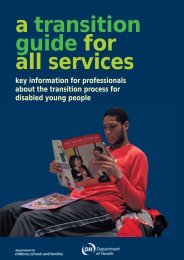NCEPOD: Trauma - Who Cares? - London Health Programmes
NCEPOD: Trauma - Who Cares? - London Health Programmes
NCEPOD: Trauma - Who Cares? - London Health Programmes
Create successful ePaper yourself
Turn your PDF publications into a flip-book with our unique Google optimized e-Paper software.
CHAPTER 7 - Management of circulationCase study 3An elderly patient was involved in a road traffi c collision.The patient arrived at hospital speaking, pulse 120 butblood pressure was unrecordable. The patient becameagitated and was intubated. A chest x-ray, pelvicx-ray and abdominal ultrasound were performed. Theultrasound of the abdomen revealed a splenic injuryand free fl uid in the peritoneal space. The patient wasthen transferred to CT for chest, abdomen, head andspine. During this time the patient was unstable andreceived seven litres of fl uid and fi ve units of blood.Following CT scanning, the patient was transferred tocritical care to be stabilised prior to laparotomy andthoracotomy. At surgery splenic and liver injuries werepacked and a diaphragmatic tear repaired. The patientreturned from theatre unstable despite inotropic supportand subsequently arrested and died. The casenotesdid not document any consultant involvement in themanagement of this patient and the advisors believedthat this was an avoidable death.Appropriateness of CT scanningIt was judged by the clinical advisors that a CT scan wasnecessary in 466 of the cases. Seventeen patients did nothave a CT when the advisors thought that it was required. Afurther 21 cases had a CT scan but it was assessed as beingunnecessary.Reasons for assessment that the CT scan was unnecessary(21cases) were:• The patient was shocked with obviousintraperitoneal haemorrhage and it was felt thatimmediate surgery, rather than imaging, wasrequired (five cases)• FAST had revealed free fluid and it was felt that nofurther imaging should have been required prior tosurgery (five cases)• No indication for imaging (six cases)• No reason was supplied for this assessment(five cases).Appropriateness of assessment ofhaemorrhageIn general it was assessed that the possibility ofhaemorrhage was investigated satisfactorily in 90.9%(610/671) of cases. However, in 61/671 cases (9.1%) itwas considered that the possibility of haemorrhage was notinvestigated satisfactorily. In 124 cases there was insuffi cientinformation to assess this.76
















